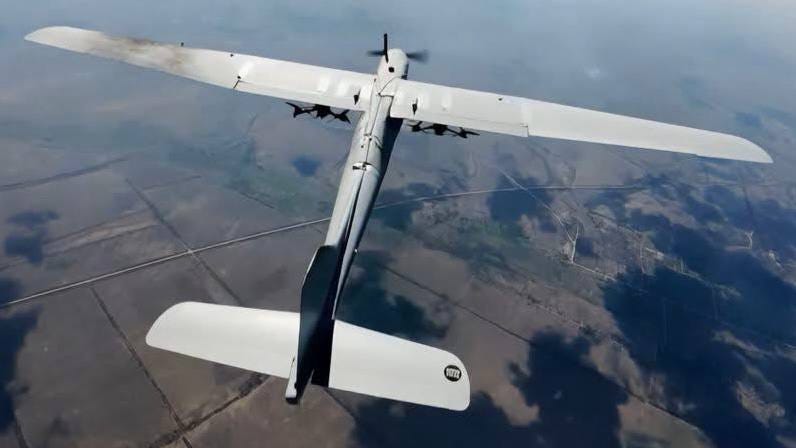Russia And Ukraine Turn To Fixed-Wing "Motherships" To Launch, Control, And Extend Range Of Multirotor Drones
🇷🇺 🇺🇦 Commentary
Earlier in the Russia-Ukraine War, both countries started to experiment with using multirotor drones as aerial radio relays/repeaters to extend the maximum range—as well as the lowest possible altitude—that armed “first-person video” multirotor drones of the radio frequency communication uplink/downlink variety could operate. In time, both countries began to use larger multirotor drones to serve as a “mothership” for one or more smaller multirotor drones that could be launched from a location closer to, if not beyond, the frontlines. Multirotor drones serving as “motherships” were typically also configured as aerial radio relays/repeaters. There is mounting evidence that a similar evolution is taking place with fixed-wing drones in the Russia-Ukraine War.
The above video, which was notably recorded by a Russian drone employed as an anti-aircraft interceptor, shows a Ukrainian vertical take-off-and-landing (VTOL) fixed-wing drone carrying two—seemingly armed—“FPV” multirotor drones under its wings. In effect, these “FPV” uncrewed aircraft-turned-munitions are being employed as air-launched munitions. Fixed-wing “mothership” drones, which do not have to be VTOL designs—the Ukrainian design in the above video has four electrically-powered rotors in addition to the primary propeller used for lateral movement that is mounted on the fuselage—regularly operate at distances of 20-60 kilometers behind the frontlines. This is well beyond the practical range of armed “FPV” multirotor drones of the radio frequency communication uplink/variety controlled via a low-lying ground-based radio antenna. A “mothership” fixed-wing drone can, therefore, be used to greatly increase the range of the armed “FPV” multirotor drones.
I place mothership in quotations because the “FPV” multirotor drones carried and launched by the “mothership” fixed-wing drone cannot be recovered but are instead employed as single-use air-to-ground guided munitions in the same manner that an attack helicopter or fighter jet will carry and release single-use guided munitions. While the “FPV” multirotor drones carried under the wings can be unarmed and, in principle, reusable, these are in practice being employed as guided air-to-ground munitions. A true “mothership” should, I think, be capable of recovering—and perhaps relaunching—its embarked systems.
“Mothership” fixed-wing drones, which are reusable designs, are typically optimized for use in ISR missions and are, therefore, typically equipped with an electro-optical sensor of much higher quality than the inexpensive designs that are typically installed on single-use armed “FPV” multirotor drones in the Russia-Ukraine War. Optimization for use in ISR missions also means that these tend to have glide-optimized airframes offering a maximum endurance that is measured in hours. The maximum practical range of any human-in-the-loop uncrewed aircraft/drone is primarily determined by the nature of its communication uplink/downlink, not the interplay of its airframe and propulsion system, and both Russia and Ukraine primarily use fixed-wing drones that are equipped with line-of-sight radio datalinks as opposed to beyond-line-of-sight satellite communications. Given the above, an unarmed fixed-wing ISR drone turned “mothership” equipped with one or more armed “FPV” multirotor drones in the manner of a guided air-to-ground munition can loiter for several hours at a distance of some 40-60 kilometers from the frontlines and attack one or more targets with uncrewed (multirotor) aircraft-turned-munitions that are likely to have a maximum range of at least 5-10 kilometers.
While Ukraine has been at the forefront of many developments in uncrewed aircraft technology in the context of the Russia-Ukraine War, it is important to recognize that the barriers to entry for much of what Ukraine has done are fairly low. Russia is, therefore, well-positioned to emulate Ukrainian approaches in this and other areas, much as Ukraine is well-positioned to emulate Russian approaches in this and other areas. The above image shows a Russian Orlan fixed-wing ISR drone carrying two (seemingly armed) “FPV” multirotor drones while serving as a “mothership.”
The use of fixed-wing drones as “motherships” carrying and launching armed “FPV” multirotor drones amounts to an important development, but is nevertheless taking place at a time when both Russia and Ukraine are intercepting slower fixed-wing drone designs with increasing regularity as a result of the mutual adoption of interceptor drones—slower and less complex propeller-driven analogues to rocket-powered anti-aircraft missiles—of both the multirotor and fixed-wing variety. Even so, this amounts to a practical way to increase the maximum reach of armed “FPV” multirotor drones and, more generally, offers militaries around the world a new and very distinct type of guided air-to-ground munition that is not only very inexpensive but can also be used in very distinct ways and to attack very distinct targets against which many existing air-to-ground munitions are not suitable. This is one area of military technology that is likely to spread far beyond the Russia-Ukraine War.


